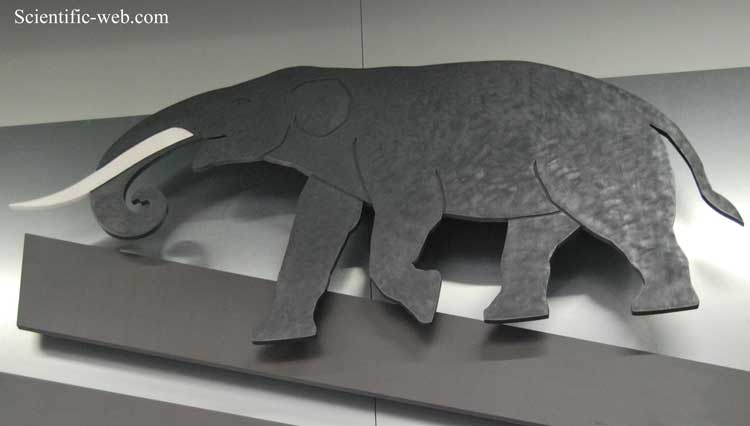Cladus: Eukaryota
Supergroup: Opisthokonta
Regnum: Animalia
Subregnum: Eumetazoa
Cladus: Bilateria
Cladus: Nephrozoa
Cladus: Deuterostomia
Phylum: Chordata
Subphylum: Vertebrata
Infraphylum: Gnathostomata
Superclassis: Tetrapoda
Classis: Mammalia
Subclassis: Theria
Infraclassis: Placentalia
Superordo: Afrotheria
Cladus: Paenungulata
Ordo: Proboscidea
Familia: †Gomphotheriidae
Genus: Cuvieronius
Species C. hyodon - C. priestleyi - C. tropicus
Cuvieronius is an extinct New World genus of gomphothere. It is named after the French naturalist Georges Cuvier, stood 2.7m (9 ft) tall and looked like a modern elephant except for its spiral-shaped tusks.
Origin
This animal initially evolved in North America ~10.3—10.2 million years ago (AEO) with fossil evidence uncovered in at the Tehuichila site in Hidalgo, Mexico.[2][3]. During the Great American Interchange of around 3 million years ago, Cuvieronius and two species of its sister genus Stegomastodon moved south into South America. They were the only proboscid mammals to colonize South America.[4] living as far south as Chile with specimens unearthed at the Quereo I site (Quereo Quebrada) dating to the Late Pleistocene 11,6—11,400 years ago.[5]
North America
The oldest fossil remains to date were of Cuvieronius sp. found in Lincoln County, Nevada dating to an accurate 4.6 million years ago (AEO). It was also found as far east as South Carolina and North Carolina from 1.81 million—126,000 years ago. In Florida, remains show both Cuvieronius sp. and C. tropicus living from 3.7—1.5 million years ago (AEO).[6]
South America
Remains of Cuvieronius were found in association with man, and pieces of its hide and muscle tissue have been found in Chile: “The site has also yielded 38 small pieces of animal hide and muscle tissue, some still preserved on bones of Cuvieronius. Pieces of hide also were recovered from hearth areas, living floors, and wooden structural remains. Some pieces were still attached to wooden poles, possible suggesting the presence of hide-draped huts. Pathological and other analyses of these pieces suggest that they are also of a Proboscidean.”[7] South American fossils formerly attributed to mastodons are now believed to be Cuvieronius.
Restoration
The related Stegomastodon occupied warmer, lower-altitude habitats in South America, while the smaller C. hyodon occupied cooler, higher-altitude Andean habitats. [4] It has been C14 dated to as recently as 6,060 B.P. in Yumbo, Valle del Cauca, Colombia. [8] [9]
Cuvieronius was a mixed feeder, and has been dated at least as recently as 9,100 B.P. in Monte Verde, Chile.[10] By the end of the Pleistocene, the northern limit of the range of Cuvieronius was in Mexico.[3]
References
1. ^ Cisneros, J. C. (2005). "New Pleistocene vertebrate fauna from El Salvador". Revista Brasileira de Paleontologia 8 (3): 239–255. doi:10.4072/rbp.2005.3.09.
2. ^ Paleobiology database, Collection 18746, Tehuichila site, State of Hidalgo, Mexico. John Alroy April 30, 1994.
3. ^ a b Graham, R. W. (2001). 709.pdf "Late Quaternary Biogeography and Extinction of Proboscideans in North America". In Cavarretta, G.; Gioia, P.; Mussi, M. et al.. The World of Elephants (La Terra degli Elefanti) - Proceedings of the 1st International Congress (Atti del 1� Congrsso Internazionale), Rome October 16-20 2001. Rome: Consiglio Nazionale delle Ricerche. pp. 707–709. ISBN 88-8080-025-6. http://www.sovraintendenzaroma.it/content/download/4925/63042/file/707_ 709.pdf. Retrieved 2010-02-27
4. ^ a b Prado, J. L.; Alberdi, M. T.; Azanza, B.; Sánchez, B.; Frassinetti, D. (2005). "The Pleistocene Gomphotheriidae (Proboscidea) from South America". Quaternary International (Elsevier) 126-128: 21–30. doi:10.1016/j.quaint.2004.04.012.
5. ^ Paleobiology database, Collection 71265, Quereo Quebrada, Chile. Authority: John Alroy February 5, 1999.
6. ^ Paleobiology database. Collections (Florida) 20299 20308 20351, 20400, 20482, 20403, 20475, 20478, 20494, 58089. incl. reposits in Florida Museum of Natural History, 1.8 ma—300,000 ka, Mark D. Uhen, Ph.D. and John Alroy, Ph.D.
7. ^ Casamiquela, “South American Proboscideans: General Introduction and Reflections on Pleistocene Extinctions”, The Proboscidea: Evolution and Palaeoecology of Elephants and Their Relatives, (Oxford: Oxford University Press, 1996), 316-320.
8. ^ Rodríguez-Flórez, Carlos David; Ernesto León Rodríguez-Flórez y Carlos Armando Rodríguez (2009). "Revision of Pleistocenic Gomphotheriidae Fuana in Columbia and case report in the Department of Valle Del Cauca". Scientific Bulletin (Museum Center - Natural History Museum) 13 (2): 78–85. http://200.21.104.25/boletincientifico/downloads/Boletin13(2)_COMPLETO.pdf. Retrieved 2010-11-09.
9. ^ Correal, Gonzalo; Thomas van der Hammen (2003). "Supervivencia de Mastodontes, Megaterios y presencia del hombre en el vale del Magdalena(COLOMBIA) entre 6000 y 5000 AP.". Revista de la Academia Colombiana de Ciencias Exactas, Físicas y Naturales (Academia Colombiana) 27 (103): 159–164. http://www.accefyn.org.co/revista/Vol_27/103/1-SUPERVIVENCIA.pdf. Retrieved 2010-11-09.
10. ^ Rafael O. Labarca and Patrick G. Lopez, “Los mamíferos finipleistocénicos de la Formación Quebrada Quereo (IV Región-Chile): biogeografía, bioestratigrafía e inferencias paleoambientales”, Mastozoología Neotropical, Volume 13, Number 1, (June 2006), 89-101


